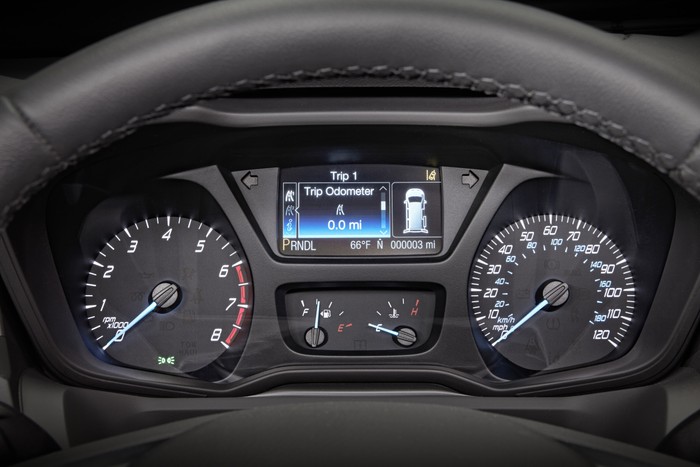

2019 Ford Transit
Ford's full-size van, the Transit, offers increased capability, better fuel economy and a much more modern driving experience than the durable but dated E-Series it replaces. The Transit is available with a choice of cargo and passenger models, three lengths, three roof heights, three engines and two trim levels, meaning nearly all buyers will be able to spec the van to suit their needs.
Recent changes
For the latest model year, the Transit gets minor changes like an increase in the standard rear door hinge opening angle to 253 degrees.
Overview
The Transit is a whole different beast than the E-Series, with a European-style design that brings a host of advantages. Its carlike unibody cuts about 300 lbs. of weight, improving both efficiency and handling. An aerodynamic shape further boosts mileage and also allows for a panoramic windshield with excellent forward visibility.
Despite those changes, the Transit is no pantywaist - in fact, it can handle a heavier payload than the E-Series, and the long-wheelbase, high-roof models can pack much more cargo inside (not to mention fit a 6'5' person standing up). Touches like a lower load floor, step bumper and 270-degree rear doors make life easier, and Transit cargo models leave the factory prepped for the installation of racks, bins, shelves and whatever else the job might require.
Engine options start out with a 3.7-liter V6 that produces 270 horsepower and 250 lb-ft of torque. More power can be had with a twin-turbocharged 3.5-liter "EcoBoost” V6 that's good for 310 horsepower and 400 lb-ft of torque, and there's also a 3.2-liter turbodiesel five-cylinder with 190 ponies and 410 lb-ft of twist. All three send power to the rear wheels through a six-speed automatic transmission.
The inside story
The Transit's cabin looks much like an XXL-sized version of Ford's latest car models, with user-friendly ergonomics, easy-to-read gauges and rugged materials. Storage bins and cubbies abound, providing plenty of space for drinks, change, pens and the rest of life's detritus. There's even an overhead storage for larger items like folders or notebooks.
All Transits come standard with front air conditioning, power windows and locks, two 12V powerpoints, a two-speaker AM/FM stereo with an AUX input jack, and 16-inch steel wheels. A range of optional niceties is available, including a rearview camera with trailer hitch assist, lane departure warning, a navigation system and an eight-speaker sound system with SYNC.
SYNC is a Bluetooth-based connectivity system that allows smartphone users to place calls and stream music by using voice commands or steering wheel-mounted buttons. SYNC can also read incoming texts aloud to help the driver keep his or her eyes on the road, and allows the use of Ford-approved apps like The Wall Street Journal news and Pandora radio.
Models and configurations
The Transit is available in four models - the 150, 250, 350 and 350HD - that each offer different towing/hauling capabilities, and can be spec'd with a different range of potential configurations.
The latter include Regular, Long and Jumbo lengths that measure up to 219.9 inches, 237.6 inches or 265.9 inches, respectively. Low (82.4 inches), Medium (99.2 inches) and Tall (110.1 inches) roof heights can also be had, with the lowest featuring a 60/40 hinged passenger side rear door and the taller two getting a sliding passenger side rear door. Dual sliding rear doors are optional, as are a number of cargo side/rear end arrangements ranging from windows all around to no windows.
Wagon models can be spec'd to seat up to 15 passengers, while cargo models strip out all the rear seats to make massive room in back.
Transit 150
The entry-level 150 can be equipped with all three engines, Regular and Long lengths, and Low and Medium roof heights. When properly equipped, it can tow up to 7,600 lbs. or handle a payload of 3,600 lbs. Its Gross Vehicle Weight Rating checks in at 8,600 lbs.
Transit 250
Like the 150, the 250 offers all three engines, but it extends the buyer's options to all three lengths and roof heights. Towing and payload capacities max out at 7,300 and 4,000 lbs, respectively, while the GVWR is 9,000 lbs.
Transit 350
The 350 can't be spec'd with the diesel engine, though it's available with all length and height options. Towing tops out at 7,200 lbs., payload ranges up to 4,390 lbs, and the GVWR is 9,600 lbs.
Transit 350HD
Available only as a Tall roof, Jumbo length van with the EcoBoost or diesel engines, the 350HD is rated to tow up to 7,000 lbs. and haul up to 4,650 lbs. Its GVWR is 10,360 lbs.
Occupant safety
All Transits are fitted as standard with dual front airbags, stability control and a tire-pressure monitoring system.
Unlike 95 percent of modern vehicles, the Transit does not come standard with side airbags and side-curtain airbags. These safety items are not offered as options, either.
At least buyers can pay extra for a lane departure warning system.
Key competitors
The Transit faces off against the front-wheel-drive, Euro-flavored Ram Promaster, and at the top end, against the Mercedes-Benz Sprinter. Buyers can also consider the Nissan NV and Chevrolet's aging Express.























- Propulsion: Gas 3.7L I4
- Power: 270hp
@
6500rpm - Torque: 250ft⋅lb
@
4000rpm - Mileage: TBD MPG ( TBD city, TBD hwy)
- Transmission: 6-speed Automatic
- Seating: 2 seats
in
1 row - Passenger Volume: TBDcu ft
- Length: 219.9in
- Wheelbase: 130.0in
- Height: 83.6in
- Weight: 4866lbs
- Cargo Volume: 246.7cu ft
- Front Leg Room: 41.3in
- Front Head Room: 40.8in
- Front Hip Room: 67.5in
- Drag Coefficient: TBD
- Drag Coefficient: TBD